 Ashuku Nyorai, Ashuku Buddha
Ashuku Nyorai, Ashuku Buddha

Ashuku 阿閦, Ashukuba 阿閦婆, Ashukuhi 阿閦鞞
Imperturbable Buddha, Free from Anger 不動佛
Important to Esoteric Sects of Buddhism in Japan & Asia
Origin = India
Lord of Eastern Paradise called Zenke 善快 (Jp.),
aka the Realm of Joy, or Land of Great Delight, aka
the paradise Abhirata in Sanskrit (Chn. = 阿比羅提國).
One of Five Buddha of Wisdom in Esoteric Buddhism.
One of Four Buddha of Four Directions 四方四佛.
One of 13 Shingon Deities for Memorial Services.
Protects Eastern Realm in Japan’s Ryōkai Mandara.
Shown often with right hand in Earth-Touching Mudra.
Represents east, earth, sound, blue, mind, others.
INTRO: Ashuku is one of four Buddha guarding Dainichi Nyorai in the Diamond World Mandala (Sanskrit = Vajradhatu, Japanese = Kongōkai Mandara). The five, with Dainichi in the center surrounded by the four protectors, each representing one of the four cardinal compass directions, are especially important to the Shingon Sect of Japanese Esoteric Buddhism. See Godai Nyorai (Five Tathagata, Five Dhyāni Buddha) page for details on all five deities.
The guardian of the east, Ashuku represents numerous attributes, including the element earth, the sense of sound, the color blue/green, and the mind. See Godai Nyorai (Five Buddha) page for details. In Japanese mandala artwork. Ashuku is also sometimes depicted sitting atop an elephant (symbolizing great strength in overcoming all obstacles).
Ashuku is not heavily represented in Japanese artwork outside of Shingon’s mandala tradition. Says the Flammarion Guide: “Akṣobhya is mentioned from the beginning of the third century AD in the Prajnaparamita sutra, and also later in the Saddharmapundarika sutra and Sukhavati-vyuha. His cult appears in China from the later Han period. Introduced into Japan at the same time as the two great mandala (early 9th century), he enjoyed little popularity and was soon eclipsed by Yakushi Nyorai (who also reigns over an eastern paradise). After the Heian period, during which Akṣobhya was worshipped by the followers of the esoteric sects, he was no longer represented except in mandalas, in the company of the other Gochi Nyorai (Five Buddha of Wisdom). However, in Japan, he is still one of the Thirteen Deities of the Shingon Sect.” <end Flammarion quote>
Adds the Digital Dictionary of Buddhism (sign in with User Name = guest): “Brief descriptions of Akṣobhya can be found in the Amitâbha-sūtra and the Vimalakīrti-nirdeśa-sūtra, but most extensive details can be found in the Sūtra of the Land of Akṣobhya Buddha 阿閦佛國經 T 313.11.751-764.” <end quote>
Says JAANUS: “Ashuku appears in various mandara, sometimes even replacing Dainichi Buddha as the central deity. In Japan he also figures among the Thirteen Buddhas (Jūsanbutsu 十三仏), presiding over the memorial service held on the sixth anniversary of a person's death. His principal iconographical characteristic is the right-hand gesture of touching the ground (Shokuchi-in 触地印), which symbolizes his spiritual "immovability." His left hand either lies in his lap clenched to form the "adamantine fist"(kongōken 金剛拳), or it may hold a corner of his robe. Usually given the color blue, his distinctive animal vehicle (chōjūza 鳥獣座) is the elephant. His seed-syllable (Shuji 種子) is UN 吽 (Skt. = hum), and his esoteric symbol (Sanmayagyō 三昧耶形) is either a single five-pronged (kongōsho 金剛杵) or two five-pronged kongōsho arranged in the shape of an inverted T. Owing to the early decline of his cult, there are no independent images of Ashuku made in Japan whose authenticity is certain. Examples of his image may be seen in sets of the Five Wisdom Tathagata.” <end JAANUS quote>
NOTE BY SITE AUTHOR: As one of the thirteen, Ashuku is known as Renge-ō 蓮華王 (Lotus King).

ASHUKU BUDDHA in the Kongōkai (Diamond World) Mandala
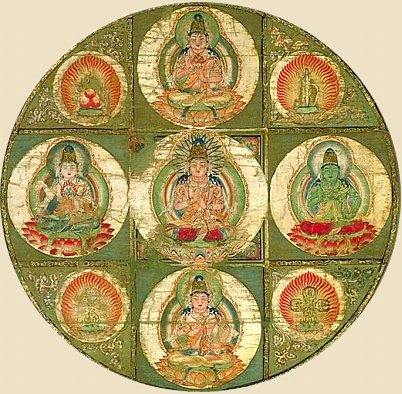
Closeup from Kongōkai (Diamond World) Mandala
Image in center is Dainichi Nyorai
Kyōōgokoku-ji 教王護国寺 Temple (Tōji 東寺), Heian Period, 9th Century AD
Photo scanned from temple catalog.
North (Top) = Fukūjyōju | South (Bottom) = Hōshō
Left (West) = Amida | Right (East) = Ashuku (green-colored deity)

At Kakuon-ji Temple 覚園寺 in Kamakura, there is a wooden statue of Ashuku (see below photo), reportedly carved in 1322 AD by a local sculptor named Inkō 院康 (years of birth/death unknown). During the Kamakura Era, there were sculptors whose name began with "in," like Inkei and In'no. Inkei fashioned a sedentary statue of Priest Ken'nichi Koho (enshrined at Kencho-ji Temple in Kamakura), while In'no is thought to be the creator of a statue of Priest Sho-in Myogen (enshrined at Engaku-ji Temple, also in Kamakura). Both are considered excellent sculptors of the 14th century, and belong to a school of sculpture called the "In" school. <above paragraph courtesy of Kondo Takahiro>
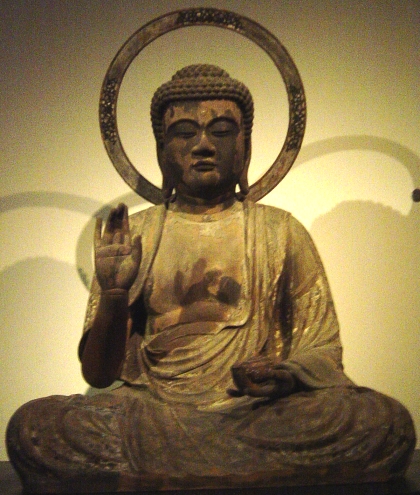
Ashuku Nyorai, Treasure of Kakuon-ji 覚園寺 Temple (Kamakura)
Height = 115 cm (about 3.77 feet); Date 1322 AD, Late Kamakura Era
Wood Carving by Inkō 院康; deity holding medicine jar in left hand
The statue of Ashuku Nyorai enshrined at Kakuon-ji Temple in Kamakura (see above photo) was originally thought to be Yakushi Nyorai (the Medicine Buddha), for Yakushi is typically shown holding a medicine jar in the left hand. But at some point, the temple priests discovered an inscription hidden inside the head of the statue, which gave both the name of the deity (Ashuku) and the artist (Inkō) who carved the statue. Nevertheless, Yakushi Nyorai is also closely associated with the eastern quarter -- Yakushi is the Lord of the Eastern Pure Land of Lapis-Lazuli, while Ashuku is the Lord of the Eastern Land of Great Delight. In some traditions, Yakushi and Ashuku are said to inhabit the same body.

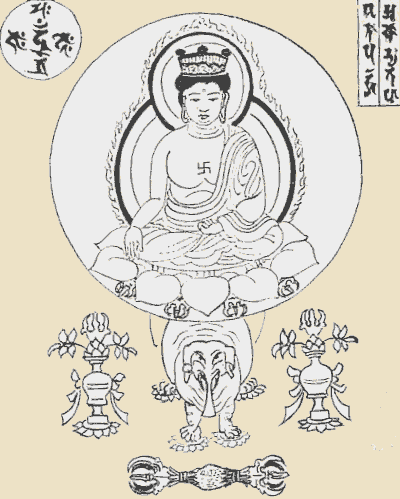
Ashuku Nyorai atop elephant
Courtesy Flammarion Guide
Shown with right hand in Earth-Touching Mudra

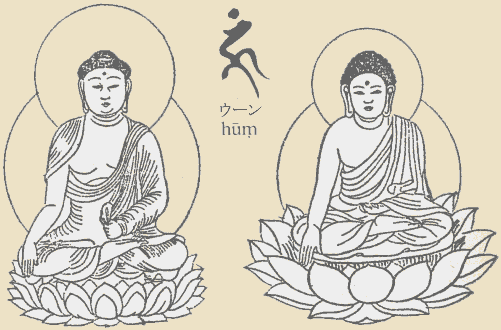
Ashuku Nyorai in the Kongōkai Mandala 金剛界曼荼 (Diamond World Mandara, Skt. = Vajradhātu)
Clipart from Big Catalog of Japan's Buddhist Statues
Shown with right hand in Earth-Touching Mudra

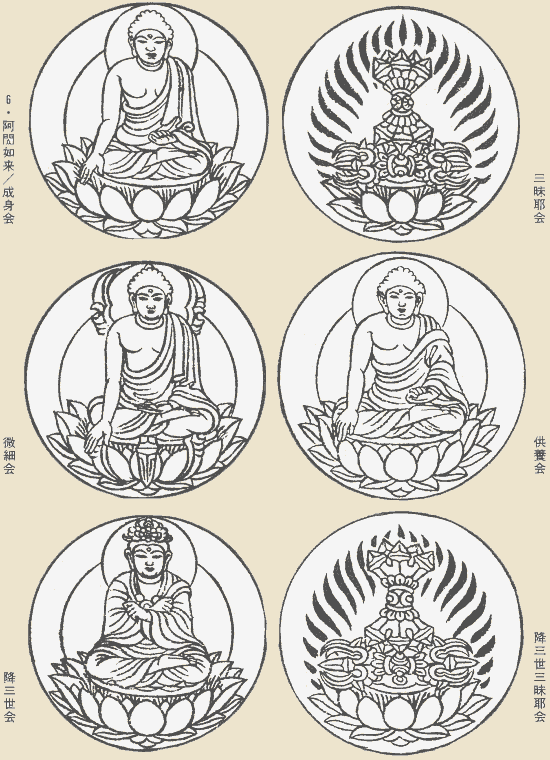
Various representations of Ashuku Nyorai in the
Kongōkai Mandala 金剛界曼荼 (Diamond World Mandara, Skt. = Vajradhātu)
Clipart from Mandara Zuten 曼荼羅図典
Shown often with right hand in Earth-Touching Mudra

BELOW TEXT COURTESY OF: Dictionary of Chinese Buddhist Terms by Soothill & Hodous
Akṣobhya, 不動佛 不動如來; 阿閦鞞 or 阿閦婆. One of the 五智如來 Five Wisdom, or Dhyāni-Buddhas, viz., Vairocana, Akṣobhya, Ratnasambhava, Amitābha, and Amoghasiddhi. He is especially worshipped by the Shingon sect, as a disciple of Vairocana. As Amitābha is Buddha in the western heavens, so Akṣobhya is Buddha in the eastern heaven of Abhirati, the realm of joy, hence he is styled 善快 or 妙喜, also 無瞋恚 free from anger. His cult has existed since the Han dynasty, see the Akṣobhya-Tathāgatasya-vyūha. He is first mentioned in the prajnapāramitā sutra, then in the Lotus, where he is the first of the sixteen sons of Mahābhijñā-jñānabhibhu. His dhyāni-bodhisattva is Vajrapāṇi. His appearance is variously described, but he generally sits on a lotus, feet crossed, soles upward, left hand closed holding robe, right hand fingers extended touching ground calling it as color is pale gold, some say blue a vajra is before him. His esoteric word is Hum; his element the air, his human form Kanakamuni, v. 拘. Jap. Ashuku, Fudo, and Mudo; Tib. mi-bskyod-pa, mi-'khrugs-pa (mintug-pa); Mong. Ülü küdelükci. <end quote >
BELOW TEXT COURTESY OF: manjushri.com
Ashuku = Japanese. Aksobhya = Sanskrit (means "Immovable" or "Unshakable"). Chinese = Ah-Chu-For. Tibetan = Mi Kyu Pa or Sang Gye. Ashuku is mentioned in several Mahayana sutras. He is a major deity within Vajrayana Buddhism, residing in the eastern quarter of the mandala, surrounded by numerous forms of the green and white Tara Bosatsu. Ashuku is found throughout all four tantra classifications, most notably in the Anu-yoga class. His consort is Lochana, and they represent the Tathagata family, space, and all encompassing wisdom.
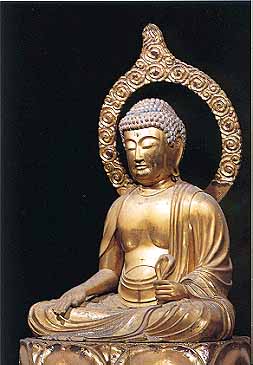
Ashuku Nyorai. Unknown date and location
Photo: manjushri.com/BUDDHA/Akshobhya.html
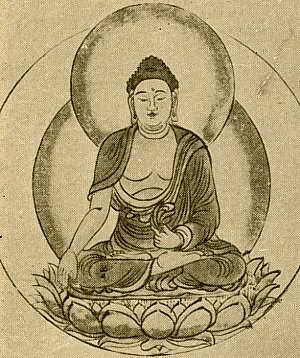
仏像図典 by 佐和研隆, First Published 1962
Purchase book at Amazon.co.jp
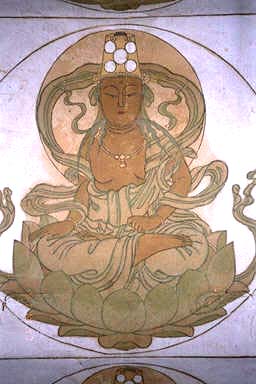
Ashuku Nyorai, Guardian of the East, in the
Kongokai Mandala (Diamond World Mandala)
Photo courtesy of the Mandala Explorer (Japanese language)
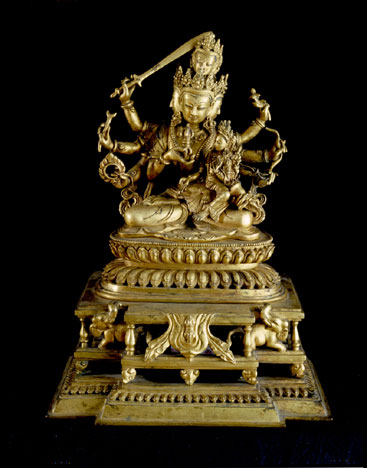
Maha-Akshobhya with Prajna from the Dharmadhatu Mandala.
See kaladarshan.arts.ohio-state.edu for details and photo.

LEARN MORE
- Dictionary of Chinese Buddhist Terms. With Sanskrit & English Equivalents. Plus Sanskrit-Pali Index. By William Edward Soothill & Lewis Hodous. Hardcover, 530 pages. Published by Munshirm Manoharlal. Reprinted March 31, 2005. ISBN 8121511453.
- Ashuku Entry at the Digital Dictionary of Buddhism (Charles Muller)
www.buddhism-dict.net/cgi-bin/xpr-ddb.pl?96.xml+id('b963f-95a6-5a46')
The 'immovable buddha (不動佛)' or 'buddha free from anger.' The buddha who learned from Mahāvairocana 大日 and who lived in a country called Abhirata 阿比羅提國 which is located in the eastern part of the universe. After achieving final enlightenment Akṣobhya created his own Pure Land called Shankuai 善快 or Miàoxǐ 妙喜, where he continues to teach. In the Esoteric School, he is one of the Five Buddhas 五佛 of the vajradhātu 金剛界, and is gold in color.
阿閦鞞; 阿閦婆; 阿芻閦耶 unmoved, imperturbable; tr. 不動; 無動 also 無怒; 無瞋恚 free from anger, according to his Buddha-vow. One of the Five Buddha, his realm Abhirata, Delightful, now being in the east, as Amitâbha's is in the west. He is the eldest son of Mahābhijñābhibhū 大通智勝, and was the Bodhisattva Jñānākara 智積 before he became a Buddha; he has other appearances. Akṣobhya is also said to mean 100 vivaras, or 1 followed by 17 ciphers, and a 大通智勝 is ten times that figure." [cmuller; source(s): Soothill]
- Butsuzō-zu-i 仏像図彙, the “Collected Illustrations of Buddhist Images.” Published in 1690 (Genroku 元禄 3). One of Japan’s first major studies of Buddhist iconography, with drawings by Tosa Hidenobu 土佐秀信 and text by Ito Takemi 伊藤武美. Hundreds of pages and drawings, with deities classified into approximately 80 (eighty) categories. Modern-day reprints are avaiable for purchase at most large Japanese book stores, or click here to purchase online.
- Mandara Zuten 曼荼羅図典 (Japanese Edition). The Mandala Dictionary. 422 pages. First published in 1993. Publisher = Daihorinkaku 大法輪閣. Language = Japanese. ISBN-10: 480461102-9. Click here to purchase book from Amazon.
- Big Catalog of Japan's Buddhist Statues 日本仏像大全書. Published in Japan by 四季社 (Shikisha), 2006. ISBN4-88405-335-4 C0095. Japanese only, 530 pages. Lots of B&W clipart. Click here to purchase book from Amazon.
- Buddhism: Flammarion Iconographic Guides. by Louis Frederic, Printed in France, ISBN 2-08013-558-9, First published 1995. A highly illustrated volume, with special significance to those studying Japanese Buddhist iconography. Includes many of the myths and legends of mainland Asia as well, but its special strength is in its coverage of the Japanese tradition. Hundreds of accompanying images/photos, both B&W and color. A useful addition to your research bookshelf.
- JAANUS aisf.or.jp/~jaanus/deta/a/ashuku.htm
- Five Satellite Deities of Kongokai Japanese Mandara
tobifudo/butuzo/13butu/ashuku.html
Japanese language only; above blue drawing from this site
- Ashuku Nyorai at Kakuon-ji Temple (Kamakura)
asahi-net.or.jp/~QM9T-KNDU/kakuonji.htm
Site covers over 70 temples and shrines in Kamakura area. By Kondo Takahiro.
- Akshobhya Mandala. There is a mandala centered on Akshobhya known as the Nine Deity Vajra Akshobhya Mandala. See himalayanart.org for details and photos.
- Shingon.org. See their page on Ashuku BUddha. shingon.org

Last Update: Sept. 2009